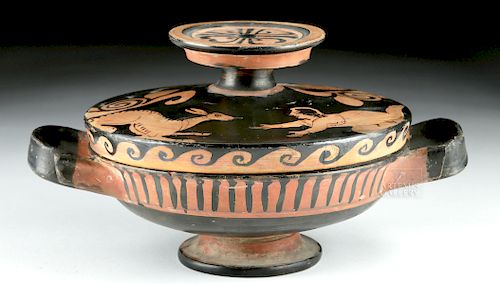Stunning Greek Ceramic Lekanis - Woman & Deer
Lot 24
About Seller
Artemis Fine Arts
686 S Taylor Ave, Ste 106
Louisville, CO 80027
United States
Selling antiquities, ancient and ethnographic art online since 1993, Artemis Gallery specializes in Classical Antiquities (Egyptian, Greek, Roman, Near Eastern), Asian, Pre-Columbian, African / Tribal / Oceanographic art. Our extensive inventory includes pottery, stone, metal, wood, glass and textil...Read more
Estimate:
$2,500 - $3,500
Absentee vs Live bid
Two ways to bid:
- Leave a max absentee bid and the platform will bid on your behalf up to your maximum bid during the live auction.
- Bid live during the auction and your bids will be submitted real-time to the auctioneer.
Bid Increments
| Price | Bid Increment |
|---|---|
| $0 | $25 |
| $300 | $50 |
| $1,000 | $100 |
| $2,000 | $250 |
| $5,000 | $500 |
| $10,000 | $1,000 |
| $20,000 | $2,500 |
| $50,000 | $5,000 |
| $100,000 | $10,000 |
| $200,000 | $20,000 |
About Auction
By Artemis Fine Arts
Feb 6, 2019
Set Reminder
2019-02-06 10:00:00
2019-02-06 10:00:00
America/New_York
Bidsquare
Bidsquare : Ancient | Ethnographic | Fine Art
https://www.bidsquare.com/auctions/artemis-gallery/ancient-ethnographic-fine-art-3848
Featuring classical antiquities, ancient and ethnographic art from cultures encompassing the globe. Artemis Fine Arts info@artemisfinearts.com
Featuring classical antiquities, ancient and ethnographic art from cultures encompassing the globe. Artemis Fine Arts info@artemisfinearts.com
- Lot Description
Greek colonies, Southern Italy, Apulia, ca. 325 BCE. A lekanis with a large, flat knob on its lid and a foot of similar shape, creating a wonderfully symmetrical vessel. The base has been glazed a glossy black on its interior and exterior, with only small, vertical red lines around its upper body providing decoration. Two elaborate horizontal handles project from either side of the vessel, which stands on a round, diminutive foot. The lid features a scene of a woman on her knees, reaching dramatically towards a seated deer; another deer faces away from the woman. Flourishes, floral motifs, and wave forms surround them on the short sides and broad shoulder of the lid. A huge, doorknob-shaped handle - slightly wider in diameter than the foot, projecting higher than the foot is tall - rises from the center of the lid. On its upper face is a painted, abstract symbol inspired by sea life. Size: 9.25" W x 4.95" H (23.5 cm x 12.6 cm)
Lidded lekanides were cosmetic containers, often given by fathers to brides on their wedding day. This is an unusual example, because most feature generic motifs, usually the lady of fashion. Instead, this example has a scene that seems to tell a story - Who is the woman? Are the deer associated with the goddess Artemis, who was associated with the animals? Who was this vessel made for? Did the woman who received it have a particular penchant for deer or Artemis? All of these questions are fun to ponder as you look at this lovely and unique piece.
Provenance: ex-private T.S. collection, San Diego County, California, USA, acquired between 25 and 40 years ago
All items legal to buy/sell under U.S. Statute covering cultural patrimony Code 2600, CHAPTER 14, and are guaranteed to be as described or your money back.
A Certificate of Authenticity will accompany all winning bids.
We ship worldwide and handle all shipping in-house for your convenience.
#140597Lid repaired from multiple pieces. Repairs are well done and almost impossible to see, with very thin areas of overpaint along the break lines. Iridescent surface from age. Old collection label on underside. Body has also been repaired from multiple pieces, with some pitting on the interior. Pitted areas of interior have been overpainted with black but original pigment with iridescence visible on much of the surface. Old collection label on underside.Condition
- Shipping Info
-
All shipping is handled in-house for your convenience. Your invoice from Artemis Gallery will include shipping calculation instructions. If in doubt, please inquire BEFORE bidding for estimated shipping costs for individual items.
-
- Buyer's Premium



 EUR
EUR CAD
CAD AUD
AUD GBP
GBP MXN
MXN HKD
HKD CNY
CNY MYR
MYR SEK
SEK SGD
SGD CHF
CHF THB
THB

















